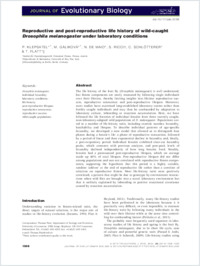Reproductive and post-reproductive life history of wild-caught Drosophila melanogaster under laboratory conditions
- Klepsatel, P. Institut für Populationsgenetik
- Gáliková, M. Institut für Populationsgenetik
- De Maio, Nicola Institut für Populationsgenetik
- Ricci, S. Dipartimento di Matematica
- Schlötterer, C. Institut für Populationsgenetik
- Flatt, Thomas Wissenschaftskolleg zu Berlin, Berlin, Germany
-
2013
Published in:
- Journal of Evolutionary Biology. - 2013, vol. 26, no. 7, p. 1508–1520
English
The life history of the fruit fly (Drosophila melanogaster) is well understood, but fitness components are rarely measured by following single individuals over their lifetime, thereby limiting insights into lifetime reproductive success, reproductive senescence and post‐reproductive lifespan. Moreover, most studies have examined long‐ established laboratory strains rather than freshly caught individuals and may thus be confounded by adaptation to laboratory culture, inbreeding or mutation accumulation. Here, we have followed the life histories of individual females from three recently caught, non‐laboratory‐adapted wild populations of D. melanogaster. Populations varied in a number of life‐history traits, including ovariole number, fecundity, hatchability and lifespan. To describe individual patterns of age‐specific fecundity, we developed a new model that allowed us to distinguish four phases during a female's life: a phase of reproductive maturation, followed by a period of linear and then exponential decline in fecundity and, finally, a post‐ovipository period. Individual females exhibited clear‐cut fecundity peaks, which contrasts with previous analyses, and post‐peak levels of fecundity declined independently of how long females lived. Notably, females had a pronounced post‐reproductive lifespan, which on average made up 40% of total lifespan. Post‐reproductive lifespan did not differ among populations and was not correlated with reproductive fitness components, supporting the hypothesis that this period is a highly variable, random ‘add‐on’ at the end of reproductive life rather than a correlate of selection on reproductive fitness. Most life‐ history traits were positively correlated, a pattern that might be due to genotype by environment interactions when wild flies are brought into a novel laboratory environment but that is unlikely explained by inbreeding or positive mutational covariance caused by mutation accumulation.
- Faculty
- Faculté des sciences et de médecine
- Department
- Département de Biologie
- Language
-
- English
- Classification
- Biological sciences
- License
- License undefined
- Identifiers
-
- RERO DOC 324303
- DOI 10.1111/jeb.12155
- Persistent URL
- https://folia.unifr.ch/unifr/documents/307546
Statistics
Document views: 66
File downloads:
- 2013_rpr.pdf: 175
